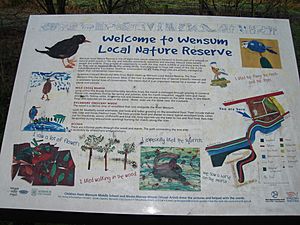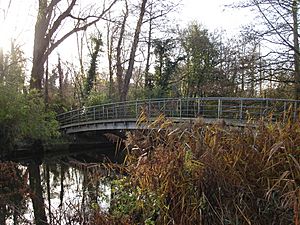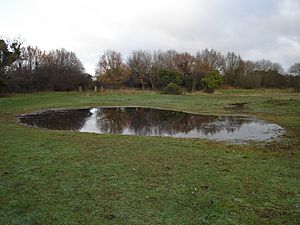Wensum Local Nature Reserve facts for kids
The Wensum Local Nature Reserve is a special place in Norwich, England, where nature is protected. It's made up of two main areas: Mile Cross Marsh 52°38′31″N 1°15′57″E / 52.6419°N 1.2657°E and Sycamore Crescent Wood. These two spots are connected by a walking path called the Riverside Path, which crosses the Sycamore Crescent footbridge. It's a great place to explore and see local wildlife!
Contents
Exploring Sycamore Crescent Wood
Sycamore Crescent Wood is a lovely woodland area right next to the River Wensum. It's bordered by Waterworks Road to the south and some houses to the east. The wood sits on a gentle slope that faces north, which helps certain plants grow well.
What You Might See in the Wood
This part of the reserve is home to many beautiful wildflowers. In spring, you can spot bright bluebells, delicate wood anemones, and even lily of the valley. Later in the year, you might see red campion. When it's still cold, winter aconite, snowdrops, and crocuses pop up, bringing early color.
The wood also has many tall, old trees. Look out for grand beech trees, horse chestnuts, and lime trees. There's even a small group of elm trees near the Waterworks Road entrance. Along the River Wensum, there are about 400 meters of tree-lined riverside, making it a peaceful place for a walk.
Discovering Mile Cross Marsh
Mile Cross Marsh is a wetland area that's also part of the reserve. It's surrounded by two popular walking and cycling paths: the Riverside Walk to the south and the Marriott's Way (which is part of NCR1) to the north. To the west, it connects to Sweetbriar Road Meadows, another important nature site.
Life in the Marsh
The marsh is a mix of fen (a type of wetland) and damp grassland. It used to have a small pond that was a busy spot for animals. Many amphibians, like frogs and newts, used the pond for breeding. It was also a hunting ground for colorful damselflies and several kinds of dragonfly.
Sometimes, if there wasn't much rain, the pond would dry out. In 2012, the pond was filled in because a plant called New Zealand pigmy weed was growing there and could have spread to the nearby nature areas, causing problems for other plants.
Even without the pond, the marsh is full of interesting plants. You can find meadowsweet, bright marsh marigolds, and tall purple loosestrife growing here. It's a great place to see how different plants thrive in wet conditions.




